NURBN 3018 Essay: RN Responsibilities and NSQHS Standards
VerifiedAdded on 2023/01/11
|8
|2989
|53
Essay
AI Summary
This essay critically examines the responsibilities of registered nurses (RNs) in leading healthcare teams to ensure adherence to National Safety and Quality Health Service (NSQHS) standards. It explores various leadership styles, such as autocratic, democratic, and strategic, and their application in managing clinical tasks and motivating staff. The essay outlines the RN's key responsibilities, including providing therapeutic environments, ensuring adequate staffing, facilitating effective communication, delegating authority appropriately, and maintaining discipline. It emphasizes the importance of role modeling and teaching effective clinical procedures, fostering team spirit, and promoting adherence to RN standards of practice, as set by the NMBA. The essay also focuses on specific NSQHS standards, including governance, consumer partnerships, infection control, patient safety, and clinical handover, highlighting their significance in enhancing patient outcomes and reducing risks.
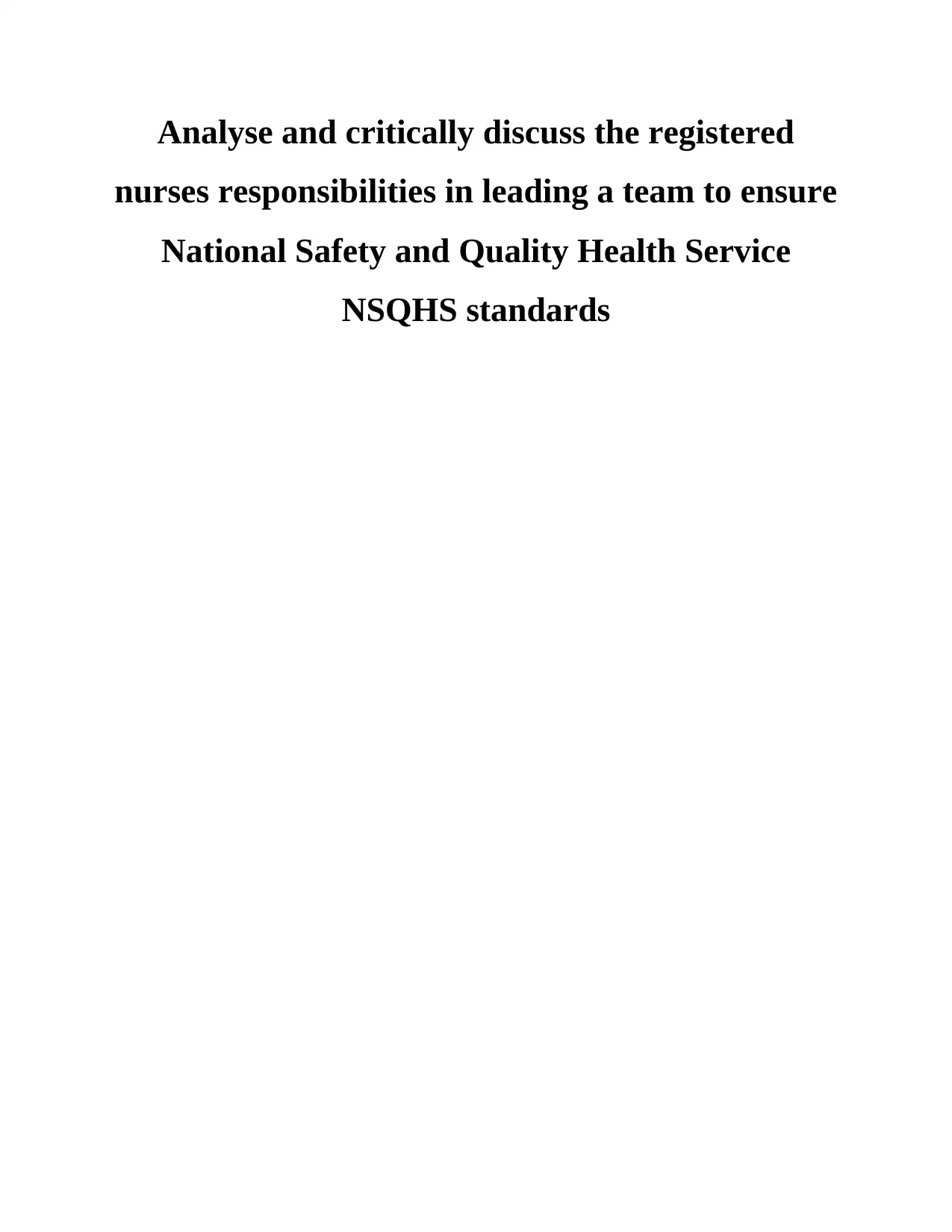
Analyse and critically discuss the registered
nurses responsibilities in leading a team to ensure
National Safety and Quality Health Service
NSQHS standards
nurses responsibilities in leading a team to ensure
National Safety and Quality Health Service
NSQHS standards
Paraphrase This Document
Need a fresh take? Get an instant paraphrase of this document with our AI Paraphraser
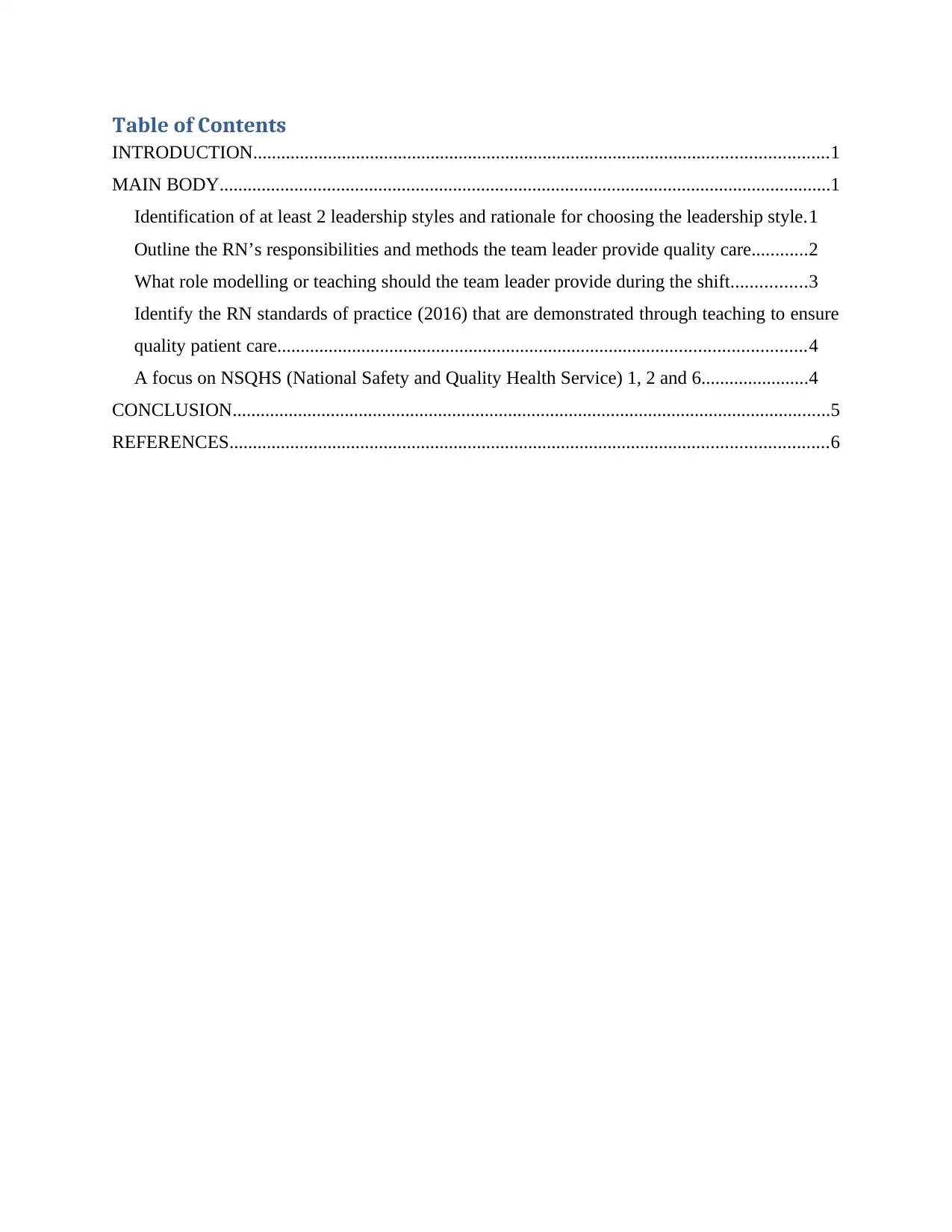
Table of Contents
INTRODUCTION...........................................................................................................................1
MAIN BODY...................................................................................................................................1
Identification of at least 2 leadership styles and rationale for choosing the leadership style.1
Outline the RN’s responsibilities and methods the team leader provide quality care............2
What role modelling or teaching should the team leader provide during the shift................3
Identify the RN standards of practice (2016) that are demonstrated through teaching to ensure
quality patient care.................................................................................................................4
A focus on NSQHS (National Safety and Quality Health Service) 1, 2 and 6.......................4
CONCLUSION................................................................................................................................5
REFERENCES................................................................................................................................6
INTRODUCTION...........................................................................................................................1
MAIN BODY...................................................................................................................................1
Identification of at least 2 leadership styles and rationale for choosing the leadership style.1
Outline the RN’s responsibilities and methods the team leader provide quality care............2
What role modelling or teaching should the team leader provide during the shift................3
Identify the RN standards of practice (2016) that are demonstrated through teaching to ensure
quality patient care.................................................................................................................4
A focus on NSQHS (National Safety and Quality Health Service) 1, 2 and 6.......................4
CONCLUSION................................................................................................................................5
REFERENCES................................................................................................................................6
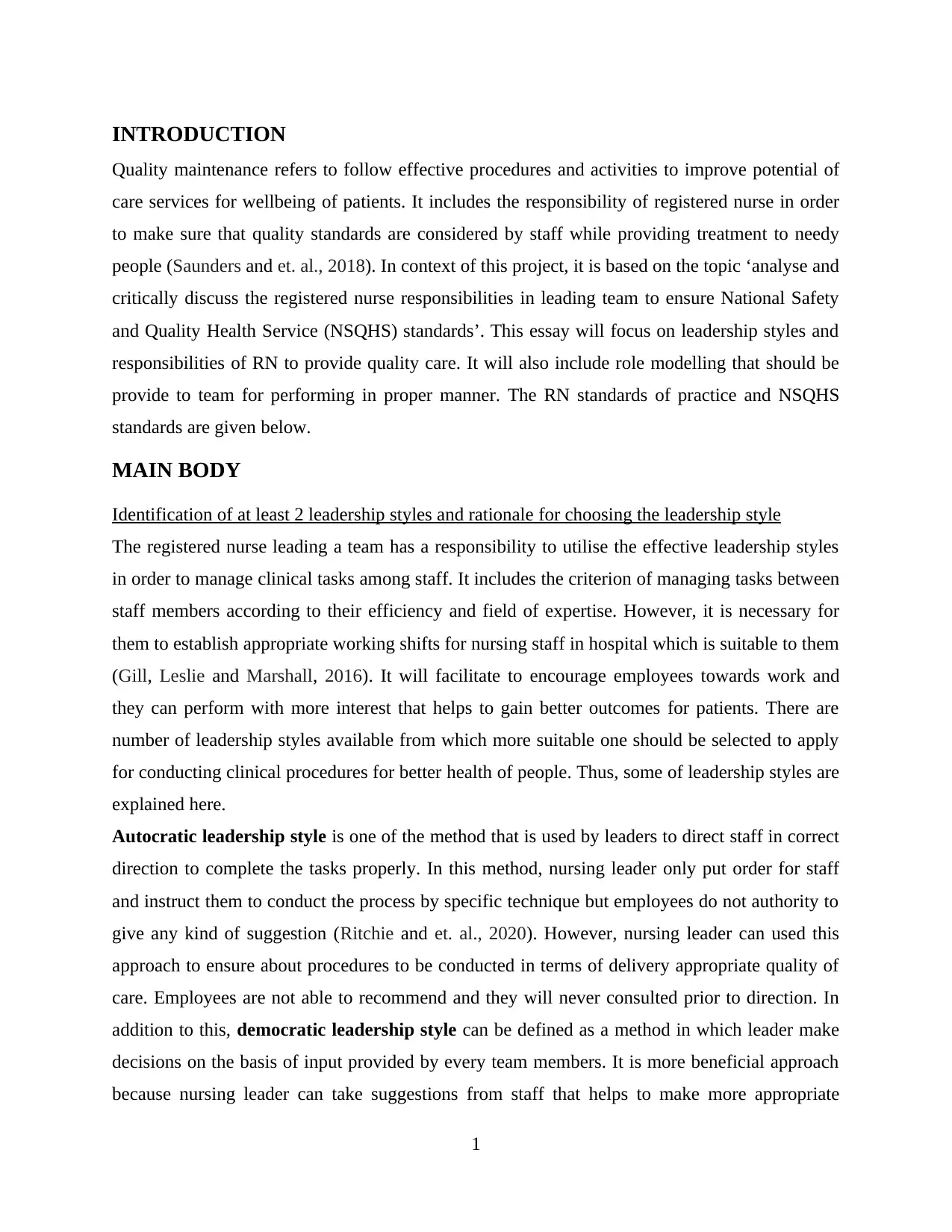
INTRODUCTION
Quality maintenance refers to follow effective procedures and activities to improve potential of
care services for wellbeing of patients. It includes the responsibility of registered nurse in order
to make sure that quality standards are considered by staff while providing treatment to needy
people (Saunders and et. al., 2018). In context of this project, it is based on the topic ‘analyse and
critically discuss the registered nurse responsibilities in leading team to ensure National Safety
and Quality Health Service (NSQHS) standards’. This essay will focus on leadership styles and
responsibilities of RN to provide quality care. It will also include role modelling that should be
provide to team for performing in proper manner. The RN standards of practice and NSQHS
standards are given below.
MAIN BODY
Identification of at least 2 leadership styles and rationale for choosing the leadership style
The registered nurse leading a team has a responsibility to utilise the effective leadership styles
in order to manage clinical tasks among staff. It includes the criterion of managing tasks between
staff members according to their efficiency and field of expertise. However, it is necessary for
them to establish appropriate working shifts for nursing staff in hospital which is suitable to them
(Gill, Leslie and Marshall, 2016). It will facilitate to encourage employees towards work and
they can perform with more interest that helps to gain better outcomes for patients. There are
number of leadership styles available from which more suitable one should be selected to apply
for conducting clinical procedures for better health of people. Thus, some of leadership styles are
explained here.
Autocratic leadership style is one of the method that is used by leaders to direct staff in correct
direction to complete the tasks properly. In this method, nursing leader only put order for staff
and instruct them to conduct the process by specific technique but employees do not authority to
give any kind of suggestion (Ritchie and et. al., 2020). However, nursing leader can used this
approach to ensure about procedures to be conducted in terms of delivery appropriate quality of
care. Employees are not able to recommend and they will never consulted prior to direction. In
addition to this, democratic leadership style can be defined as a method in which leader make
decisions on the basis of input provided by every team members. It is more beneficial approach
because nursing leader can take suggestions from staff that helps to make more appropriate
1
Quality maintenance refers to follow effective procedures and activities to improve potential of
care services for wellbeing of patients. It includes the responsibility of registered nurse in order
to make sure that quality standards are considered by staff while providing treatment to needy
people (Saunders and et. al., 2018). In context of this project, it is based on the topic ‘analyse and
critically discuss the registered nurse responsibilities in leading team to ensure National Safety
and Quality Health Service (NSQHS) standards’. This essay will focus on leadership styles and
responsibilities of RN to provide quality care. It will also include role modelling that should be
provide to team for performing in proper manner. The RN standards of practice and NSQHS
standards are given below.
MAIN BODY
Identification of at least 2 leadership styles and rationale for choosing the leadership style
The registered nurse leading a team has a responsibility to utilise the effective leadership styles
in order to manage clinical tasks among staff. It includes the criterion of managing tasks between
staff members according to their efficiency and field of expertise. However, it is necessary for
them to establish appropriate working shifts for nursing staff in hospital which is suitable to them
(Gill, Leslie and Marshall, 2016). It will facilitate to encourage employees towards work and
they can perform with more interest that helps to gain better outcomes for patients. There are
number of leadership styles available from which more suitable one should be selected to apply
for conducting clinical procedures for better health of people. Thus, some of leadership styles are
explained here.
Autocratic leadership style is one of the method that is used by leaders to direct staff in correct
direction to complete the tasks properly. In this method, nursing leader only put order for staff
and instruct them to conduct the process by specific technique but employees do not authority to
give any kind of suggestion (Ritchie and et. al., 2020). However, nursing leader can used this
approach to ensure about procedures to be conducted in terms of delivery appropriate quality of
care. Employees are not able to recommend and they will never consulted prior to direction. In
addition to this, democratic leadership style can be defined as a method in which leader make
decisions on the basis of input provided by every team members. It is more beneficial approach
because nursing leader can take suggestions from staff that helps to make more appropriate
1
⊘ This is a preview!⊘
Do you want full access?
Subscribe today to unlock all pages.

Trusted by 1+ million students worldwide
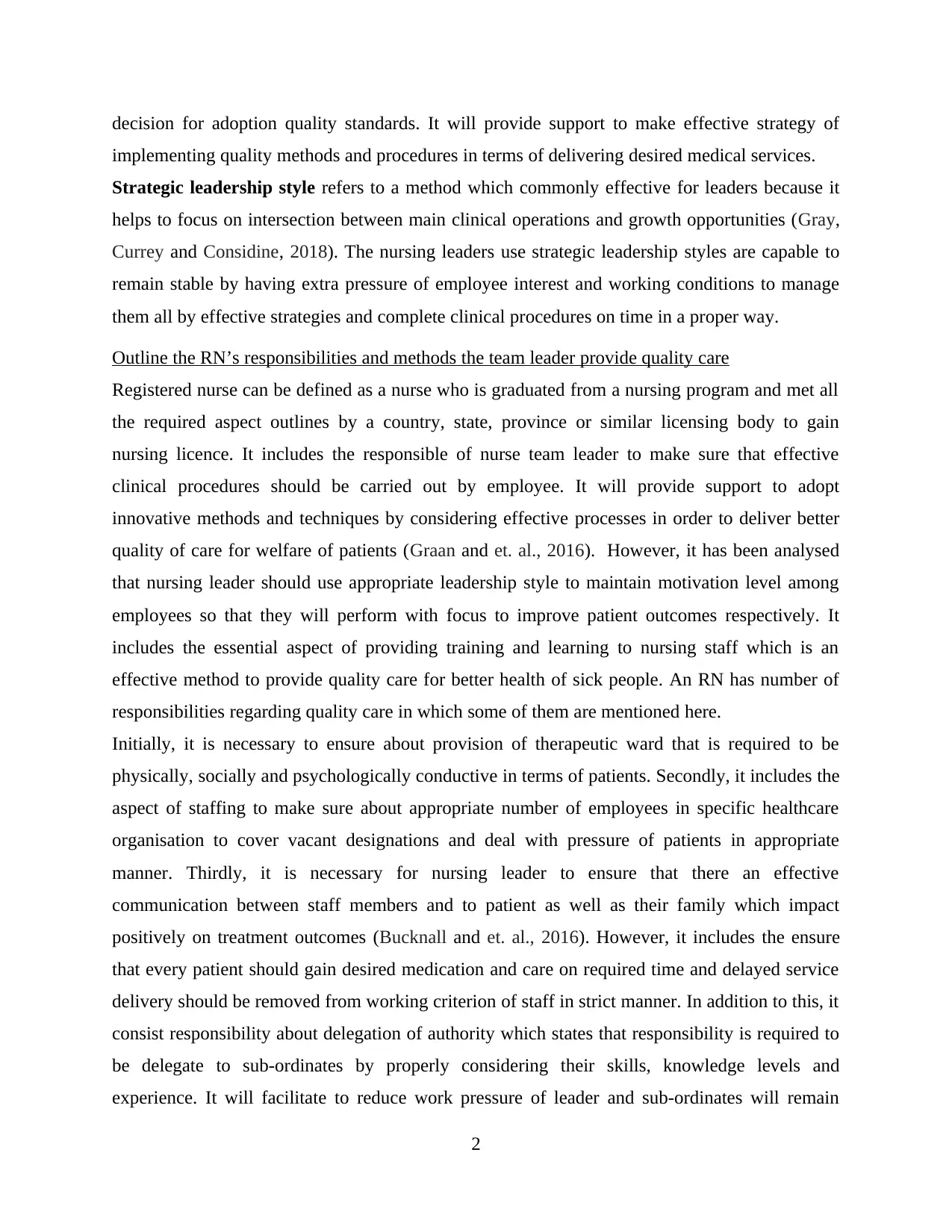
decision for adoption quality standards. It will provide support to make effective strategy of
implementing quality methods and procedures in terms of delivering desired medical services.
Strategic leadership style refers to a method which commonly effective for leaders because it
helps to focus on intersection between main clinical operations and growth opportunities (Gray,
Currey and Considine, 2018). The nursing leaders use strategic leadership styles are capable to
remain stable by having extra pressure of employee interest and working conditions to manage
them all by effective strategies and complete clinical procedures on time in a proper way.
Outline the RN’s responsibilities and methods the team leader provide quality care
Registered nurse can be defined as a nurse who is graduated from a nursing program and met all
the required aspect outlines by a country, state, province or similar licensing body to gain
nursing licence. It includes the responsible of nurse team leader to make sure that effective
clinical procedures should be carried out by employee. It will provide support to adopt
innovative methods and techniques by considering effective processes in order to deliver better
quality of care for welfare of patients (Graan and et. al., 2016). However, it has been analysed
that nursing leader should use appropriate leadership style to maintain motivation level among
employees so that they will perform with focus to improve patient outcomes respectively. It
includes the essential aspect of providing training and learning to nursing staff which is an
effective method to provide quality care for better health of sick people. An RN has number of
responsibilities regarding quality care in which some of them are mentioned here.
Initially, it is necessary to ensure about provision of therapeutic ward that is required to be
physically, socially and psychologically conductive in terms of patients. Secondly, it includes the
aspect of staffing to make sure about appropriate number of employees in specific healthcare
organisation to cover vacant designations and deal with pressure of patients in appropriate
manner. Thirdly, it is necessary for nursing leader to ensure that there an effective
communication between staff members and to patient as well as their family which impact
positively on treatment outcomes (Bucknall and et. al., 2016). However, it includes the ensure
that every patient should gain desired medication and care on required time and delayed service
delivery should be removed from working criterion of staff in strict manner. In addition to this, it
consist responsibility about delegation of authority which states that responsibility is required to
be delegate to sub-ordinates by properly considering their skills, knowledge levels and
experience. It will facilitate to reduce work pressure of leader and sub-ordinates will remain
2
implementing quality methods and procedures in terms of delivering desired medical services.
Strategic leadership style refers to a method which commonly effective for leaders because it
helps to focus on intersection between main clinical operations and growth opportunities (Gray,
Currey and Considine, 2018). The nursing leaders use strategic leadership styles are capable to
remain stable by having extra pressure of employee interest and working conditions to manage
them all by effective strategies and complete clinical procedures on time in a proper way.
Outline the RN’s responsibilities and methods the team leader provide quality care
Registered nurse can be defined as a nurse who is graduated from a nursing program and met all
the required aspect outlines by a country, state, province or similar licensing body to gain
nursing licence. It includes the responsible of nurse team leader to make sure that effective
clinical procedures should be carried out by employee. It will provide support to adopt
innovative methods and techniques by considering effective processes in order to deliver better
quality of care for welfare of patients (Graan and et. al., 2016). However, it has been analysed
that nursing leader should use appropriate leadership style to maintain motivation level among
employees so that they will perform with focus to improve patient outcomes respectively. It
includes the essential aspect of providing training and learning to nursing staff which is an
effective method to provide quality care for better health of sick people. An RN has number of
responsibilities regarding quality care in which some of them are mentioned here.
Initially, it is necessary to ensure about provision of therapeutic ward that is required to be
physically, socially and psychologically conductive in terms of patients. Secondly, it includes the
aspect of staffing to make sure about appropriate number of employees in specific healthcare
organisation to cover vacant designations and deal with pressure of patients in appropriate
manner. Thirdly, it is necessary for nursing leader to ensure that there an effective
communication between staff members and to patient as well as their family which impact
positively on treatment outcomes (Bucknall and et. al., 2016). However, it includes the ensure
that every patient should gain desired medication and care on required time and delayed service
delivery should be removed from working criterion of staff in strict manner. In addition to this, it
consist responsibility about delegation of authority which states that responsibility is required to
be delegate to sub-ordinates by properly considering their skills, knowledge levels and
experience. It will facilitate to reduce work pressure of leader and sub-ordinates will remain
2
Paraphrase This Document
Need a fresh take? Get an instant paraphrase of this document with our AI Paraphraser
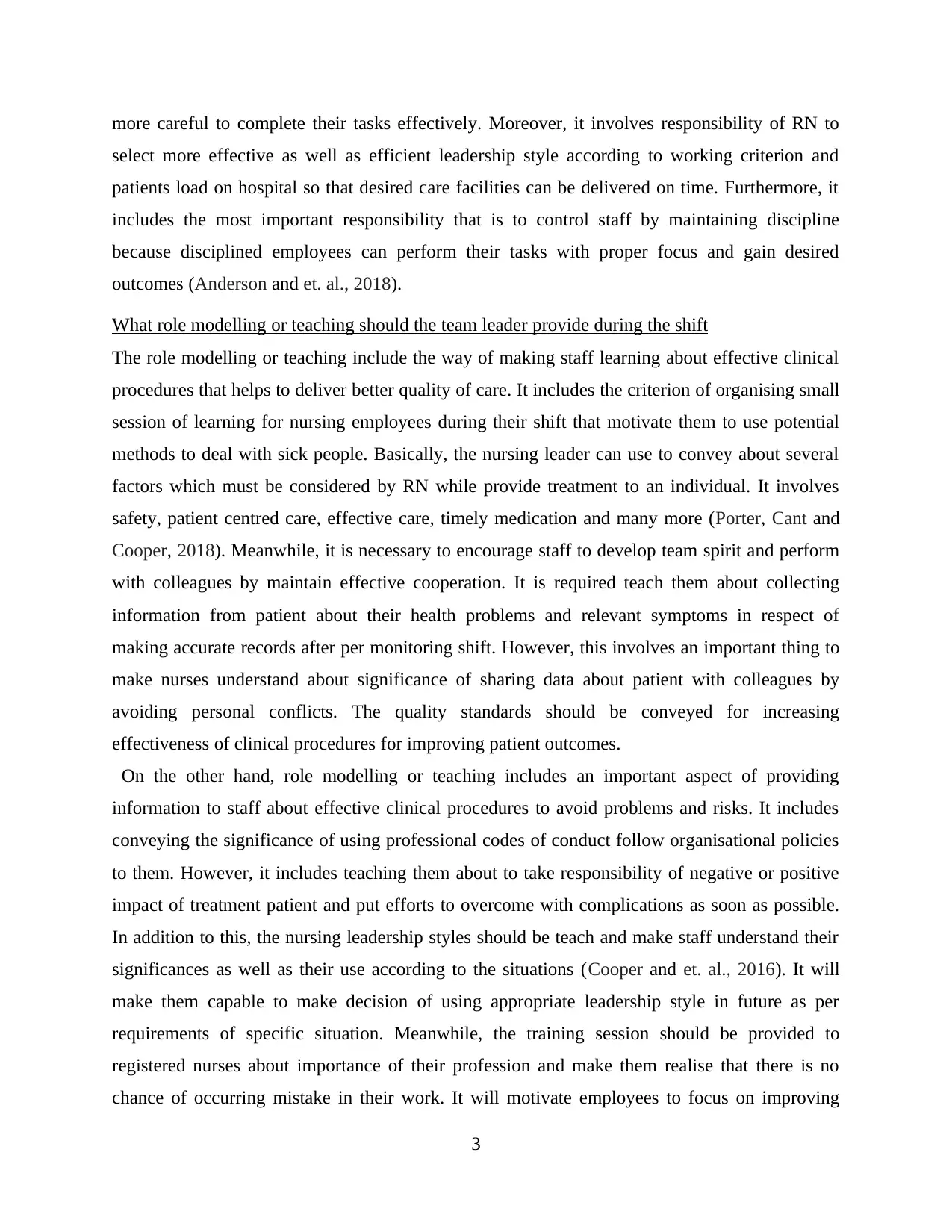
more careful to complete their tasks effectively. Moreover, it involves responsibility of RN to
select more effective as well as efficient leadership style according to working criterion and
patients load on hospital so that desired care facilities can be delivered on time. Furthermore, it
includes the most important responsibility that is to control staff by maintaining discipline
because disciplined employees can perform their tasks with proper focus and gain desired
outcomes (Anderson and et. al., 2018).
What role modelling or teaching should the team leader provide during the shift
The role modelling or teaching include the way of making staff learning about effective clinical
procedures that helps to deliver better quality of care. It includes the criterion of organising small
session of learning for nursing employees during their shift that motivate them to use potential
methods to deal with sick people. Basically, the nursing leader can use to convey about several
factors which must be considered by RN while provide treatment to an individual. It involves
safety, patient centred care, effective care, timely medication and many more (Porter, Cant and
Cooper, 2018). Meanwhile, it is necessary to encourage staff to develop team spirit and perform
with colleagues by maintain effective cooperation. It is required teach them about collecting
information from patient about their health problems and relevant symptoms in respect of
making accurate records after per monitoring shift. However, this involves an important thing to
make nurses understand about significance of sharing data about patient with colleagues by
avoiding personal conflicts. The quality standards should be conveyed for increasing
effectiveness of clinical procedures for improving patient outcomes.
On the other hand, role modelling or teaching includes an important aspect of providing
information to staff about effective clinical procedures to avoid problems and risks. It includes
conveying the significance of using professional codes of conduct follow organisational policies
to them. However, it includes teaching them about to take responsibility of negative or positive
impact of treatment patient and put efforts to overcome with complications as soon as possible.
In addition to this, the nursing leadership styles should be teach and make staff understand their
significances as well as their use according to the situations (Cooper and et. al., 2016). It will
make them capable to make decision of using appropriate leadership style in future as per
requirements of specific situation. Meanwhile, the training session should be provided to
registered nurses about importance of their profession and make them realise that there is no
chance of occurring mistake in their work. It will motivate employees to focus on improving
3
select more effective as well as efficient leadership style according to working criterion and
patients load on hospital so that desired care facilities can be delivered on time. Furthermore, it
includes the most important responsibility that is to control staff by maintaining discipline
because disciplined employees can perform their tasks with proper focus and gain desired
outcomes (Anderson and et. al., 2018).
What role modelling or teaching should the team leader provide during the shift
The role modelling or teaching include the way of making staff learning about effective clinical
procedures that helps to deliver better quality of care. It includes the criterion of organising small
session of learning for nursing employees during their shift that motivate them to use potential
methods to deal with sick people. Basically, the nursing leader can use to convey about several
factors which must be considered by RN while provide treatment to an individual. It involves
safety, patient centred care, effective care, timely medication and many more (Porter, Cant and
Cooper, 2018). Meanwhile, it is necessary to encourage staff to develop team spirit and perform
with colleagues by maintain effective cooperation. It is required teach them about collecting
information from patient about their health problems and relevant symptoms in respect of
making accurate records after per monitoring shift. However, this involves an important thing to
make nurses understand about significance of sharing data about patient with colleagues by
avoiding personal conflicts. The quality standards should be conveyed for increasing
effectiveness of clinical procedures for improving patient outcomes.
On the other hand, role modelling or teaching includes an important aspect of providing
information to staff about effective clinical procedures to avoid problems and risks. It includes
conveying the significance of using professional codes of conduct follow organisational policies
to them. However, it includes teaching them about to take responsibility of negative or positive
impact of treatment patient and put efforts to overcome with complications as soon as possible.
In addition to this, the nursing leadership styles should be teach and make staff understand their
significances as well as their use according to the situations (Cooper and et. al., 2016). It will
make them capable to make decision of using appropriate leadership style in future as per
requirements of specific situation. Meanwhile, the training session should be provided to
registered nurses about importance of their profession and make them realise that there is no
chance of occurring mistake in their work. It will motivate employees to focus on improving
3
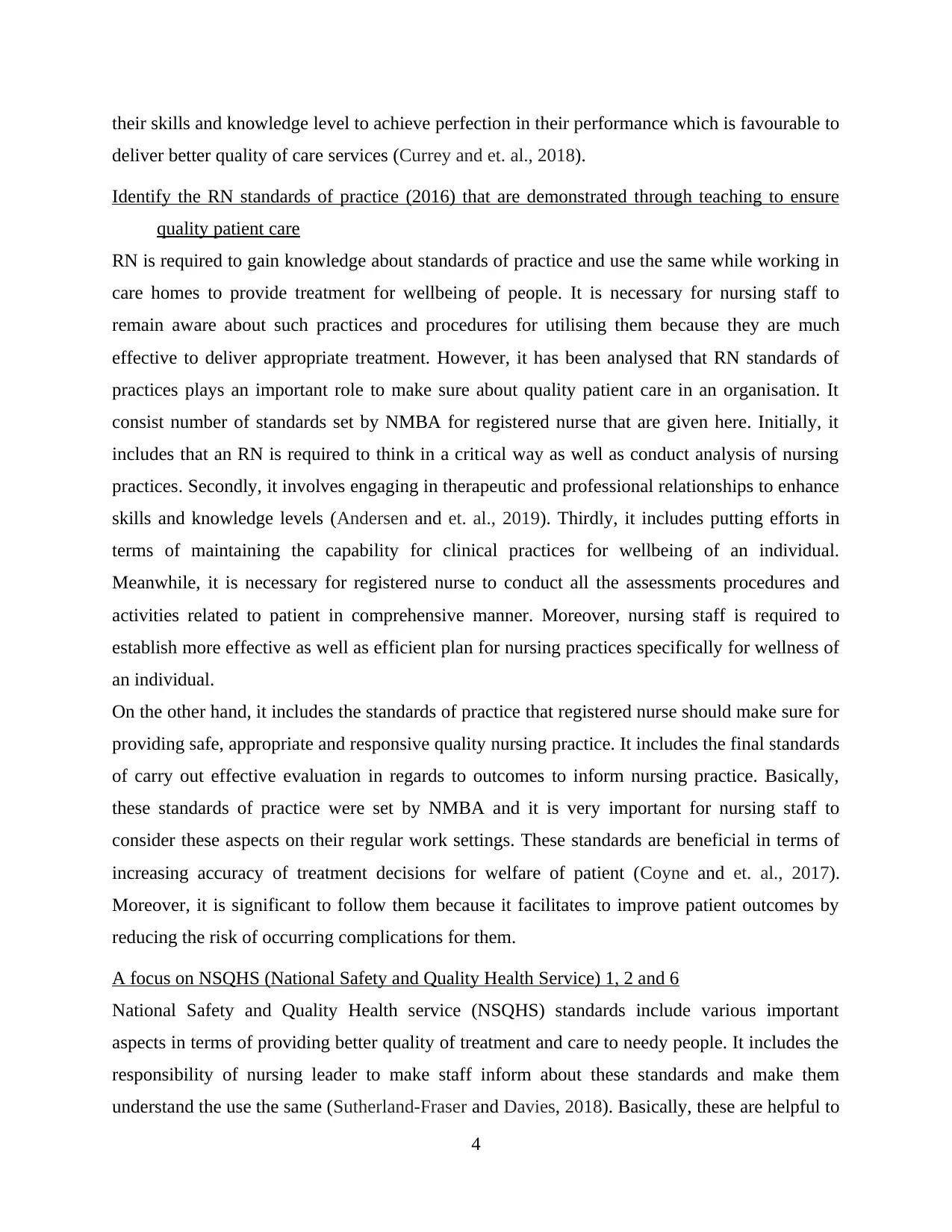
their skills and knowledge level to achieve perfection in their performance which is favourable to
deliver better quality of care services (Currey and et. al., 2018).
Identify the RN standards of practice (2016) that are demonstrated through teaching to ensure
quality patient care
RN is required to gain knowledge about standards of practice and use the same while working in
care homes to provide treatment for wellbeing of people. It is necessary for nursing staff to
remain aware about such practices and procedures for utilising them because they are much
effective to deliver appropriate treatment. However, it has been analysed that RN standards of
practices plays an important role to make sure about quality patient care in an organisation. It
consist number of standards set by NMBA for registered nurse that are given here. Initially, it
includes that an RN is required to think in a critical way as well as conduct analysis of nursing
practices. Secondly, it involves engaging in therapeutic and professional relationships to enhance
skills and knowledge levels (Andersen and et. al., 2019). Thirdly, it includes putting efforts in
terms of maintaining the capability for clinical practices for wellbeing of an individual.
Meanwhile, it is necessary for registered nurse to conduct all the assessments procedures and
activities related to patient in comprehensive manner. Moreover, nursing staff is required to
establish more effective as well as efficient plan for nursing practices specifically for wellness of
an individual.
On the other hand, it includes the standards of practice that registered nurse should make sure for
providing safe, appropriate and responsive quality nursing practice. It includes the final standards
of carry out effective evaluation in regards to outcomes to inform nursing practice. Basically,
these standards of practice were set by NMBA and it is very important for nursing staff to
consider these aspects on their regular work settings. These standards are beneficial in terms of
increasing accuracy of treatment decisions for welfare of patient (Coyne and et. al., 2017).
Moreover, it is significant to follow them because it facilitates to improve patient outcomes by
reducing the risk of occurring complications for them.
A focus on NSQHS (National Safety and Quality Health Service) 1, 2 and 6
National Safety and Quality Health service (NSQHS) standards include various important
aspects in terms of providing better quality of treatment and care to needy people. It includes the
responsibility of nursing leader to make staff inform about these standards and make them
understand the use the same (Sutherland-Fraser and Davies, 2018). Basically, these are helpful to
4
deliver better quality of care services (Currey and et. al., 2018).
Identify the RN standards of practice (2016) that are demonstrated through teaching to ensure
quality patient care
RN is required to gain knowledge about standards of practice and use the same while working in
care homes to provide treatment for wellbeing of people. It is necessary for nursing staff to
remain aware about such practices and procedures for utilising them because they are much
effective to deliver appropriate treatment. However, it has been analysed that RN standards of
practices plays an important role to make sure about quality patient care in an organisation. It
consist number of standards set by NMBA for registered nurse that are given here. Initially, it
includes that an RN is required to think in a critical way as well as conduct analysis of nursing
practices. Secondly, it involves engaging in therapeutic and professional relationships to enhance
skills and knowledge levels (Andersen and et. al., 2019). Thirdly, it includes putting efforts in
terms of maintaining the capability for clinical practices for wellbeing of an individual.
Meanwhile, it is necessary for registered nurse to conduct all the assessments procedures and
activities related to patient in comprehensive manner. Moreover, nursing staff is required to
establish more effective as well as efficient plan for nursing practices specifically for wellness of
an individual.
On the other hand, it includes the standards of practice that registered nurse should make sure for
providing safe, appropriate and responsive quality nursing practice. It includes the final standards
of carry out effective evaluation in regards to outcomes to inform nursing practice. Basically,
these standards of practice were set by NMBA and it is very important for nursing staff to
consider these aspects on their regular work settings. These standards are beneficial in terms of
increasing accuracy of treatment decisions for welfare of patient (Coyne and et. al., 2017).
Moreover, it is significant to follow them because it facilitates to improve patient outcomes by
reducing the risk of occurring complications for them.
A focus on NSQHS (National Safety and Quality Health Service) 1, 2 and 6
National Safety and Quality Health service (NSQHS) standards include various important
aspects in terms of providing better quality of treatment and care to needy people. It includes the
responsibility of nursing leader to make staff inform about these standards and make them
understand the use the same (Sutherland-Fraser and Davies, 2018). Basically, these are helpful to
4
⊘ This is a preview!⊘
Do you want full access?
Subscribe today to unlock all pages.

Trusted by 1+ million students worldwide
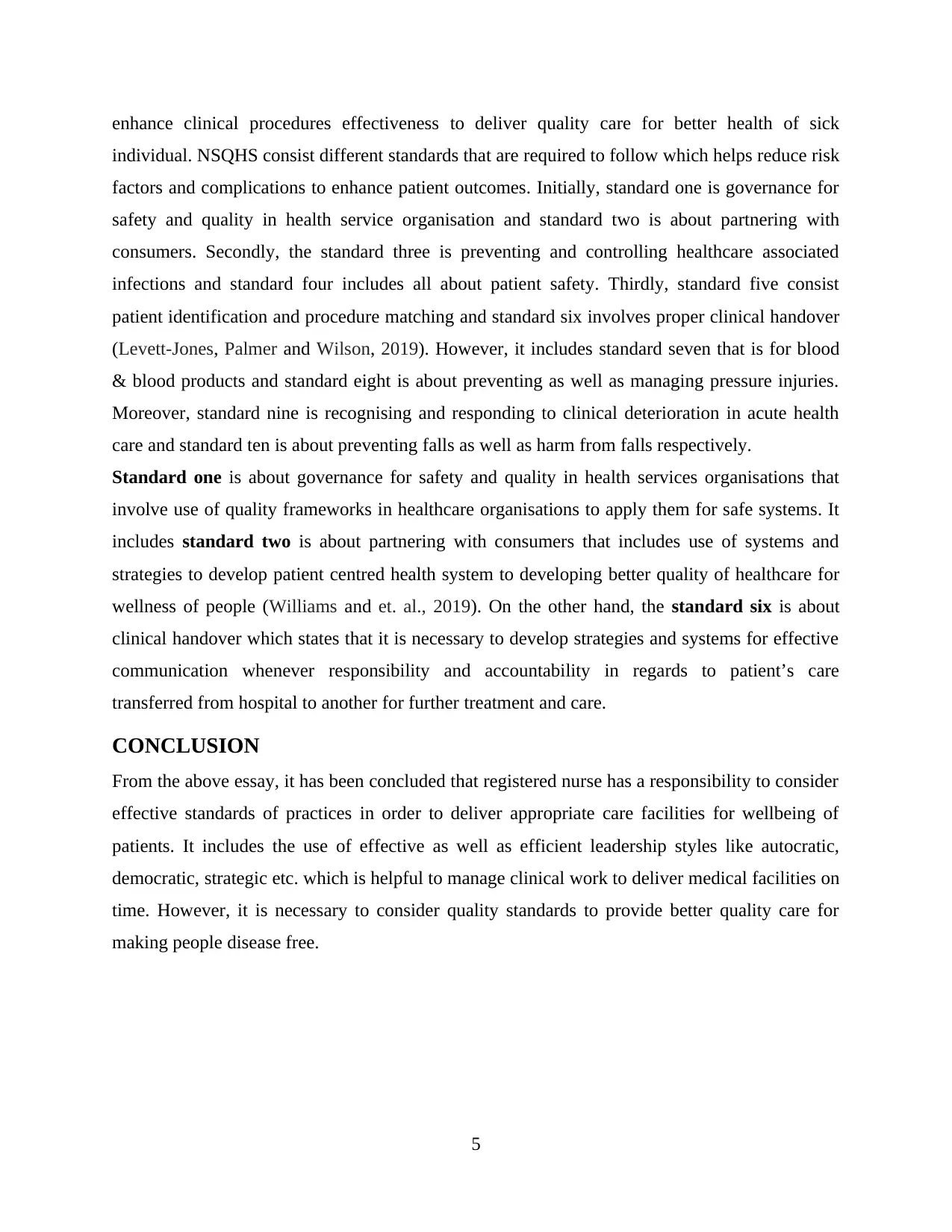
enhance clinical procedures effectiveness to deliver quality care for better health of sick
individual. NSQHS consist different standards that are required to follow which helps reduce risk
factors and complications to enhance patient outcomes. Initially, standard one is governance for
safety and quality in health service organisation and standard two is about partnering with
consumers. Secondly, the standard three is preventing and controlling healthcare associated
infections and standard four includes all about patient safety. Thirdly, standard five consist
patient identification and procedure matching and standard six involves proper clinical handover
(Levett-Jones, Palmer and Wilson, 2019). However, it includes standard seven that is for blood
& blood products and standard eight is about preventing as well as managing pressure injuries.
Moreover, standard nine is recognising and responding to clinical deterioration in acute health
care and standard ten is about preventing falls as well as harm from falls respectively.
Standard one is about governance for safety and quality in health services organisations that
involve use of quality frameworks in healthcare organisations to apply them for safe systems. It
includes standard two is about partnering with consumers that includes use of systems and
strategies to develop patient centred health system to developing better quality of healthcare for
wellness of people (Williams and et. al., 2019). On the other hand, the standard six is about
clinical handover which states that it is necessary to develop strategies and systems for effective
communication whenever responsibility and accountability in regards to patient’s care
transferred from hospital to another for further treatment and care.
CONCLUSION
From the above essay, it has been concluded that registered nurse has a responsibility to consider
effective standards of practices in order to deliver appropriate care facilities for wellbeing of
patients. It includes the use of effective as well as efficient leadership styles like autocratic,
democratic, strategic etc. which is helpful to manage clinical work to deliver medical facilities on
time. However, it is necessary to consider quality standards to provide better quality care for
making people disease free.
5
individual. NSQHS consist different standards that are required to follow which helps reduce risk
factors and complications to enhance patient outcomes. Initially, standard one is governance for
safety and quality in health service organisation and standard two is about partnering with
consumers. Secondly, the standard three is preventing and controlling healthcare associated
infections and standard four includes all about patient safety. Thirdly, standard five consist
patient identification and procedure matching and standard six involves proper clinical handover
(Levett-Jones, Palmer and Wilson, 2019). However, it includes standard seven that is for blood
& blood products and standard eight is about preventing as well as managing pressure injuries.
Moreover, standard nine is recognising and responding to clinical deterioration in acute health
care and standard ten is about preventing falls as well as harm from falls respectively.
Standard one is about governance for safety and quality in health services organisations that
involve use of quality frameworks in healthcare organisations to apply them for safe systems. It
includes standard two is about partnering with consumers that includes use of systems and
strategies to develop patient centred health system to developing better quality of healthcare for
wellness of people (Williams and et. al., 2019). On the other hand, the standard six is about
clinical handover which states that it is necessary to develop strategies and systems for effective
communication whenever responsibility and accountability in regards to patient’s care
transferred from hospital to another for further treatment and care.
CONCLUSION
From the above essay, it has been concluded that registered nurse has a responsibility to consider
effective standards of practices in order to deliver appropriate care facilities for wellbeing of
patients. It includes the use of effective as well as efficient leadership styles like autocratic,
democratic, strategic etc. which is helpful to manage clinical work to deliver medical facilities on
time. However, it is necessary to consider quality standards to provide better quality care for
making people disease free.
5
Paraphrase This Document
Need a fresh take? Get an instant paraphrase of this document with our AI Paraphraser
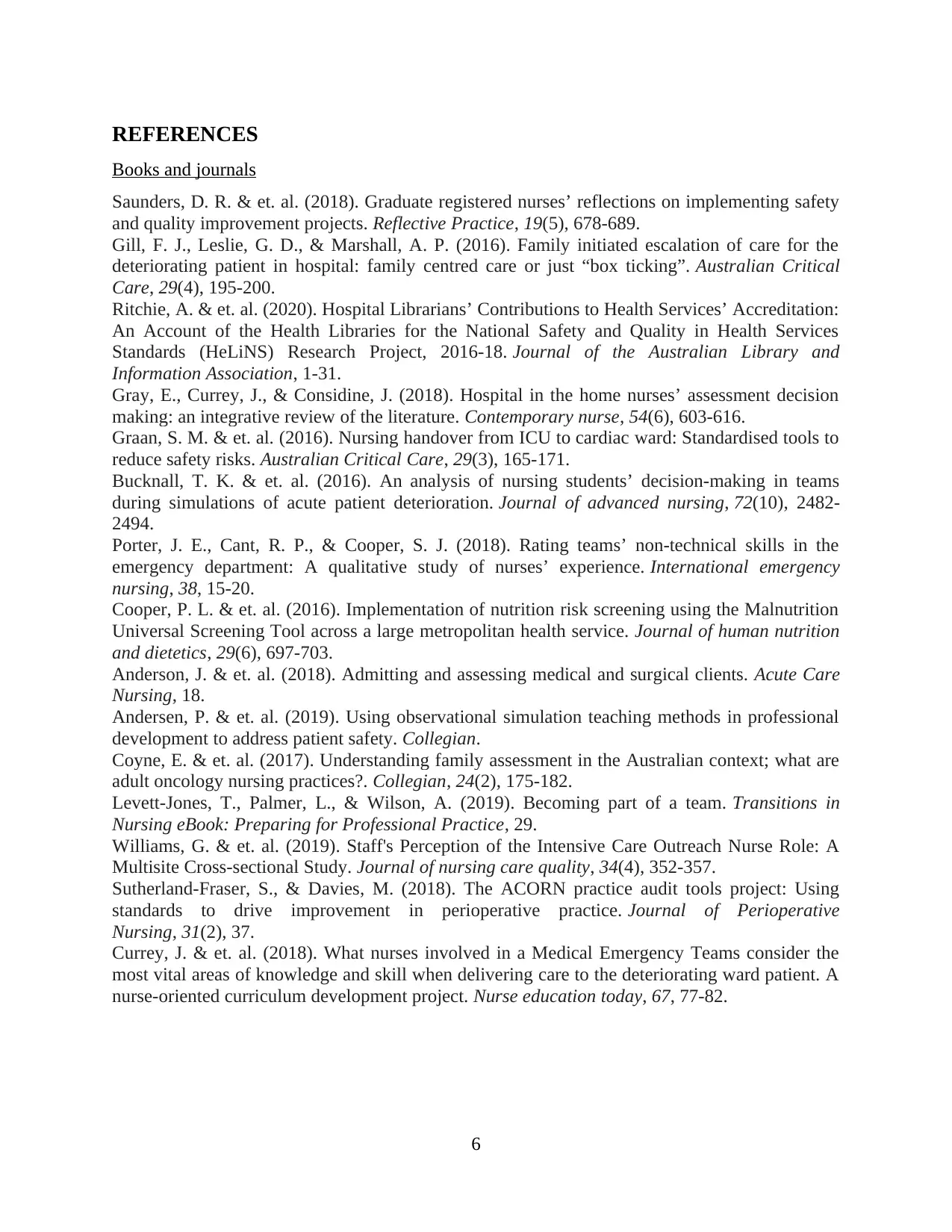
REFERENCES
Books and journals
Saunders, D. R. & et. al. (2018). Graduate registered nurses’ reflections on implementing safety
and quality improvement projects. Reflective Practice, 19(5), 678-689.
Gill, F. J., Leslie, G. D., & Marshall, A. P. (2016). Family initiated escalation of care for the
deteriorating patient in hospital: family centred care or just “box ticking”. Australian Critical
Care, 29(4), 195-200.
Ritchie, A. & et. al. (2020). Hospital Librarians’ Contributions to Health Services’ Accreditation:
An Account of the Health Libraries for the National Safety and Quality in Health Services
Standards (HeLiNS) Research Project, 2016-18. Journal of the Australian Library and
Information Association, 1-31.
Gray, E., Currey, J., & Considine, J. (2018). Hospital in the home nurses’ assessment decision
making: an integrative review of the literature. Contemporary nurse, 54(6), 603-616.
Graan, S. M. & et. al. (2016). Nursing handover from ICU to cardiac ward: Standardised tools to
reduce safety risks. Australian Critical Care, 29(3), 165-171.
Bucknall, T. K. & et. al. (2016). An analysis of nursing students’ decision‐making in teams
during simulations of acute patient deterioration. Journal of advanced nursing, 72(10), 2482-
2494.
Porter, J. E., Cant, R. P., & Cooper, S. J. (2018). Rating teams’ non-technical skills in the
emergency department: A qualitative study of nurses’ experience. International emergency
nursing, 38, 15-20.
Cooper, P. L. & et. al. (2016). Implementation of nutrition risk screening using the Malnutrition
Universal Screening Tool across a large metropolitan health service. Journal of human nutrition
and dietetics, 29(6), 697-703.
Anderson, J. & et. al. (2018). Admitting and assessing medical and surgical clients. Acute Care
Nursing, 18.
Andersen, P. & et. al. (2019). Using observational simulation teaching methods in professional
development to address patient safety. Collegian.
Coyne, E. & et. al. (2017). Understanding family assessment in the Australian context; what are
adult oncology nursing practices?. Collegian, 24(2), 175-182.
Levett-Jones, T., Palmer, L., & Wilson, A. (2019). Becoming part of a team. Transitions in
Nursing eBook: Preparing for Professional Practice, 29.
Williams, G. & et. al. (2019). Staff's Perception of the Intensive Care Outreach Nurse Role: A
Multisite Cross-sectional Study. Journal of nursing care quality, 34(4), 352-357.
Sutherland-Fraser, S., & Davies, M. (2018). The ACORN practice audit tools project: Using
standards to drive improvement in perioperative practice. Journal of Perioperative
Nursing, 31(2), 37.
Currey, J. & et. al. (2018). What nurses involved in a Medical Emergency Teams consider the
most vital areas of knowledge and skill when delivering care to the deteriorating ward patient. A
nurse-oriented curriculum development project. Nurse education today, 67, 77-82.
6
Books and journals
Saunders, D. R. & et. al. (2018). Graduate registered nurses’ reflections on implementing safety
and quality improvement projects. Reflective Practice, 19(5), 678-689.
Gill, F. J., Leslie, G. D., & Marshall, A. P. (2016). Family initiated escalation of care for the
deteriorating patient in hospital: family centred care or just “box ticking”. Australian Critical
Care, 29(4), 195-200.
Ritchie, A. & et. al. (2020). Hospital Librarians’ Contributions to Health Services’ Accreditation:
An Account of the Health Libraries for the National Safety and Quality in Health Services
Standards (HeLiNS) Research Project, 2016-18. Journal of the Australian Library and
Information Association, 1-31.
Gray, E., Currey, J., & Considine, J. (2018). Hospital in the home nurses’ assessment decision
making: an integrative review of the literature. Contemporary nurse, 54(6), 603-616.
Graan, S. M. & et. al. (2016). Nursing handover from ICU to cardiac ward: Standardised tools to
reduce safety risks. Australian Critical Care, 29(3), 165-171.
Bucknall, T. K. & et. al. (2016). An analysis of nursing students’ decision‐making in teams
during simulations of acute patient deterioration. Journal of advanced nursing, 72(10), 2482-
2494.
Porter, J. E., Cant, R. P., & Cooper, S. J. (2018). Rating teams’ non-technical skills in the
emergency department: A qualitative study of nurses’ experience. International emergency
nursing, 38, 15-20.
Cooper, P. L. & et. al. (2016). Implementation of nutrition risk screening using the Malnutrition
Universal Screening Tool across a large metropolitan health service. Journal of human nutrition
and dietetics, 29(6), 697-703.
Anderson, J. & et. al. (2018). Admitting and assessing medical and surgical clients. Acute Care
Nursing, 18.
Andersen, P. & et. al. (2019). Using observational simulation teaching methods in professional
development to address patient safety. Collegian.
Coyne, E. & et. al. (2017). Understanding family assessment in the Australian context; what are
adult oncology nursing practices?. Collegian, 24(2), 175-182.
Levett-Jones, T., Palmer, L., & Wilson, A. (2019). Becoming part of a team. Transitions in
Nursing eBook: Preparing for Professional Practice, 29.
Williams, G. & et. al. (2019). Staff's Perception of the Intensive Care Outreach Nurse Role: A
Multisite Cross-sectional Study. Journal of nursing care quality, 34(4), 352-357.
Sutherland-Fraser, S., & Davies, M. (2018). The ACORN practice audit tools project: Using
standards to drive improvement in perioperative practice. Journal of Perioperative
Nursing, 31(2), 37.
Currey, J. & et. al. (2018). What nurses involved in a Medical Emergency Teams consider the
most vital areas of knowledge and skill when delivering care to the deteriorating ward patient. A
nurse-oriented curriculum development project. Nurse education today, 67, 77-82.
6
1 out of 8
Related Documents
Your All-in-One AI-Powered Toolkit for Academic Success.
+13062052269
info@desklib.com
Available 24*7 on WhatsApp / Email
![[object Object]](/_next/static/media/star-bottom.7253800d.svg)
Unlock your academic potential
Copyright © 2020–2025 A2Z Services. All Rights Reserved. Developed and managed by ZUCOL.





